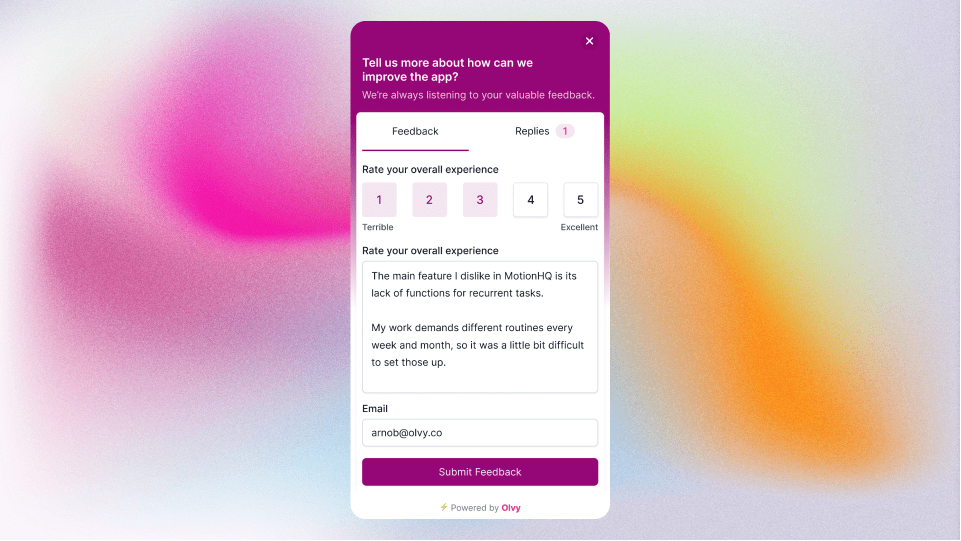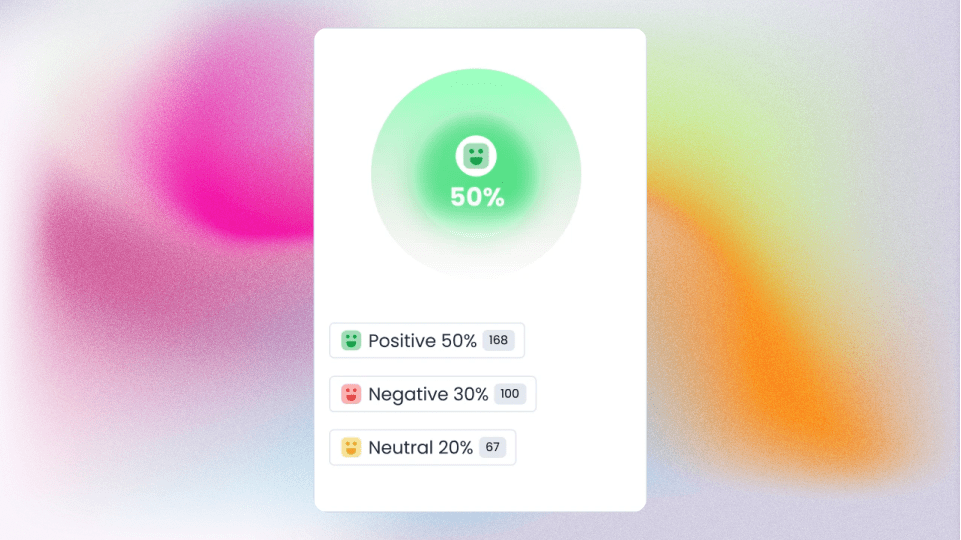In today's fast-paced digital world, businesses must continuously innovate and improve their products and services to stay ahead.
However, with so many options available to consumers, keeping up with their needs and preferences is becoming increasingly challenging. According to McKinsey, nearly 80% of consumers say they are likelier to do business with a company offering personalized experiences.
So, how can businesses ensure that they're meeting the needs of their customers and providing the personalized experiences they crave?
The answer lies in collecting user feedback.
In this blog, we'll explore the importance of collecting user feedback, the various methods you can use to gather feedback, and how to analyze and act on the feedback you receive.
Let's get started!
What Is User Feedback?
User feedback refers to the information, opinions, and reactions provided by users or customers of a product, service, or system. It is a critical tool for businesses and organizations to understand how their target audience interacts with their offerings.
Answering the question "How do users feel about our app?" will help you to understand:
- What is working for you?
- What you can improve in your app.
Let's say you run an e-commerce website and notice that your sales have declined.
By collecting customer feedback, you might find your website difficult to navigate, your checkout process needs to be more precise, or your product descriptions need to be revised. This information lets you change your website and improve the overall customer experience. It'll ultimately lead to increased sales and customer satisfaction.
Top 5 Ways To Collect User Feedback
There are many ways to collect user feedback. Here are some of the more popular ones:
1. Surveys
A survey is the most common way to get feedback from users. The survey can be as simple as an email with a few questions or more elaborate — for example, using a site like Typeform or SurveyMonkey. You can also use Google Forms to create your surveys.
Conducting a survey is an effective method of obtaining feedback from a sizable audience, enabling you to perform quantitative analysis that facilitates comparison and benchmarking of customer views.
Additionally, it allows for resolving numerous inquiries with minimal personal involvement compared to face-to-face interviews with users.
2. Interviews
Interviews are a great way to learn about customers' needs, preferences, and goals. They can be done in person or over the phone, lasting for several hours or just a 5-minute conversation. Interviews are also an excellent way to gather qualitative data about people's feelings and opinions about your product.
You can use miro's user interview template to create interviews easily and quickly.
Give each participant a prototype of your site or app and ask them to complete a task or set of tasks. Then, ask them questions afterward (or at the end) about their experience using it — what worked well, what didn't work so well, etc.

3. Usability Testing
Usability testing is a technique for evaluating the usability of a product by testing it on users. Usability tests are generally conducted by experienced members of the target audience, who are observed as they try the product.
You can use open-ended questions and listen carefully to what users say. It'll help you understand their problems, goals, and motivations.
Open-ended questions cannot be answered with a "yes" or "no." They require more information and thought, which is why they're so effective.
Here are some examples of open-ended questions:
- What do you like about this product?
- Why do you like it?
- Do you dislike something particular about the product?
- What would be a better way for me to solve the problem?
- What were your expectations coming into this test today? How did they differ from the experience?
- What would it be if you could add one thing to [subject matter]?
4. Customer Support Emails And Tickets
HubSpot's research indicates that email is the preferred mode of communication for 62% of customers seeking customer service, 48% prefer phone calls, 42% prefer live chat, and 36% use "contact us" options.
If you have an email address that customers can reach you at, you can use this to ask them for feedback about their experience using your product or service.

You can set up a dedicated support channel where customers can ask questions and provide feedback. It gives you a chance to improve your customer support process. It's because you'll make it easier for customers to reach out when they need help.
5. Social Media Monitoring
Sprout Social reports that 47% of customers complaining about a product or service will express themselves on social media. As a result, maintaining a presence on social media platforms can improve the likelihood of obtaining feedback.
Social media sites like Facebook, Twitter, Instagram, and LinkedIn offer tools for businesses to monitor trends in their industry. However, it's important to note that social media monitoring differs from engaging with your customers on those platforms.
Monitoring involves passively tracking what people say about your brand online without directly responding to or engaging with them.
Why Is User Feedback Important?
There are many reasons why user feedback is important for your product team. Let's take a look at some of them:
1. Validate Assumptions
The first step in any product development process is learning about the needs and expectations of your target audience.
You may have developed an idea based on your personal experiences or those of your co-workers. But, before starting down the path of building features for your new project, you must validate that those assumptions are correct. You can do this through usability testing or conducting interviews with potential customers.
2. Identify Areas For Improvement
User feedback can help identify pain points, areas where users may struggle, and features or functionalities that are missing or not working as expected.
For example, if users need help understanding how to use an app or website, the user interface may be too complicated. If they frequently click on buttons that don't work, you should remove those buttons from the interface altogether.

Customers unsatisfied with your product or service will tell you about it through their feedback. It allows you to make changes based on what they have said and improve the overall experience of using your product or service.
3. Build Better Features And Products
As a product manager, your primary responsibility is to create products that solve real problems for your clients or users. However, sometimes you miss vital features simply because you don't know what your users need.
For instance, a user tells you their favorite feature of your product is the ability to insert photos into text easily. You now know that this feature needs further development. This feedback is essential if other users share the same sentiment and may even be willing to pay more for this feature.
By asking your clients what they want from your product, you can build more useful features that, in turn, can increase their satisfaction with your product, and they are more likely to recommend it to others. As a result, your product becomes more competitive, and your business thrives.
4. Win Customer Loyalty
When users feel heard and see that their feedback is being acted upon, they are likelier to feel a sense of ownership and investment in the product. It can increase trust and advocacy, as they are more likely to recommend the product to others and continue using it themselves.
Increased customer loyalty can lead to increased user retention, higher customer satisfaction, and, ultimately, increased revenue for the product.
Why Don't Most Users Provide Feedback?
User feedback is essential for any business to improve its product. But it's not easy to get, especially from regular customers. There are several reasons why users may not provide feedback:
- Lack of motivation: Users may not feel motivated to provide feedback if they don't see the value. They may not see how their feedback will be used, or they may not think that their opinions matter.
- Difficulty in providing feedback: Providing feedback can be time-consuming and require effort from the user. If the feedback process is complicated or requires users to jump through multiple hoops, they may be less likely to provide feedback.
- Lack of awareness: Users may not know that feedback is an option or learn how to provide it. If the feedback option is buried deep within a website or application, users may not even realize it exists.
- Fear of retribution: Some users may be hesitant to provide negative feedback out of fear of retribution. They may worry that their negative feedback will be traced back to them, resulting in negative consequences.
- Satisfaction with the product: If users are satisfied, they may not feel the need to provide feedback. They may assume that the product team is already aware of what works well and may not have any suggestions for improvement.
What Are The Best Ways To Ask For Feedback?
Asking for feedback is an integral part of improving any product or service, and it's essential to do it in a way that is respectful, clear, and effective. Here are some tips for asking for feedback:
- Be clear about your ask: Make sure the user knows what you're asking for feedback on, whether it's a specific feature or the overall user experience.
- Provide context: Let the user know why their feedback is essential and how you plan to use it to improve your product or service.
- Use open-ended questions: Ask questions that allow the user to provide detailed and honest feedback rather than just yes or no answers.
- Be specific: Ask targeted questions that relate to the user's experience, such as "What was your favorite part of using our product?" or "What could we do to improve our customer service?"
- Make it easy: Provide a simple and user-friendly way for users to give feedback, such as a feedback tool. With a feedback tool, users can quickly provide their feedback and suggestions in a structured and organized manner without needing back-and-forth communication via email or phone.
- Thank the user: Show appreciation for the user's time and effort in providing feedback, and let them know their feedback is valued and appreciated. You need to address even the negative feedback respectfully.
Wrapping Up
If you're creating an app or website, your ultimate goal is to make money. But to do that, first, you need to create something that users want to use (and pay for). That's why user feedback is so important—it gives you insight into what might otherwise be a blind creation process.
Several ways to collect user feedback include surveys, feedback forms, and social media listening. However, using a customer feedback tool like Olvy can make the process more efficient and streamlined. With Olvy, you can create and distribute surveys, collect real-time feedback, and analyze the data to gain valuable insights into your customers' opinions and behaviors.
If you want to take your feedback collection efforts to the next level, try out Olvy. Sign up for a free trial today and see how it can help you connect with your customers and improve your business.
Frequently Asked Questions (FAQs)
1. How do you collect user feedback on a website?
You can use tools such as feedback widgets, pop-up surveys, and feedback forms to collect user feedback on a website. You can also analyze website analytics to understand user behavior and gather insights. User testing and customer interviews can provide additional qualitative feedback on the user experience.
2. What are the three types of feedback?
Three feedback techniques are highly successful in practice: feedforward, DESC, and the what/why technique. These methods are known for their effectiveness in providing feedback to individuals.


